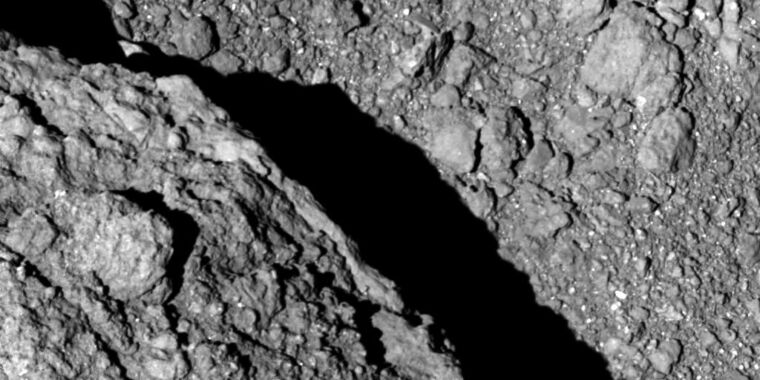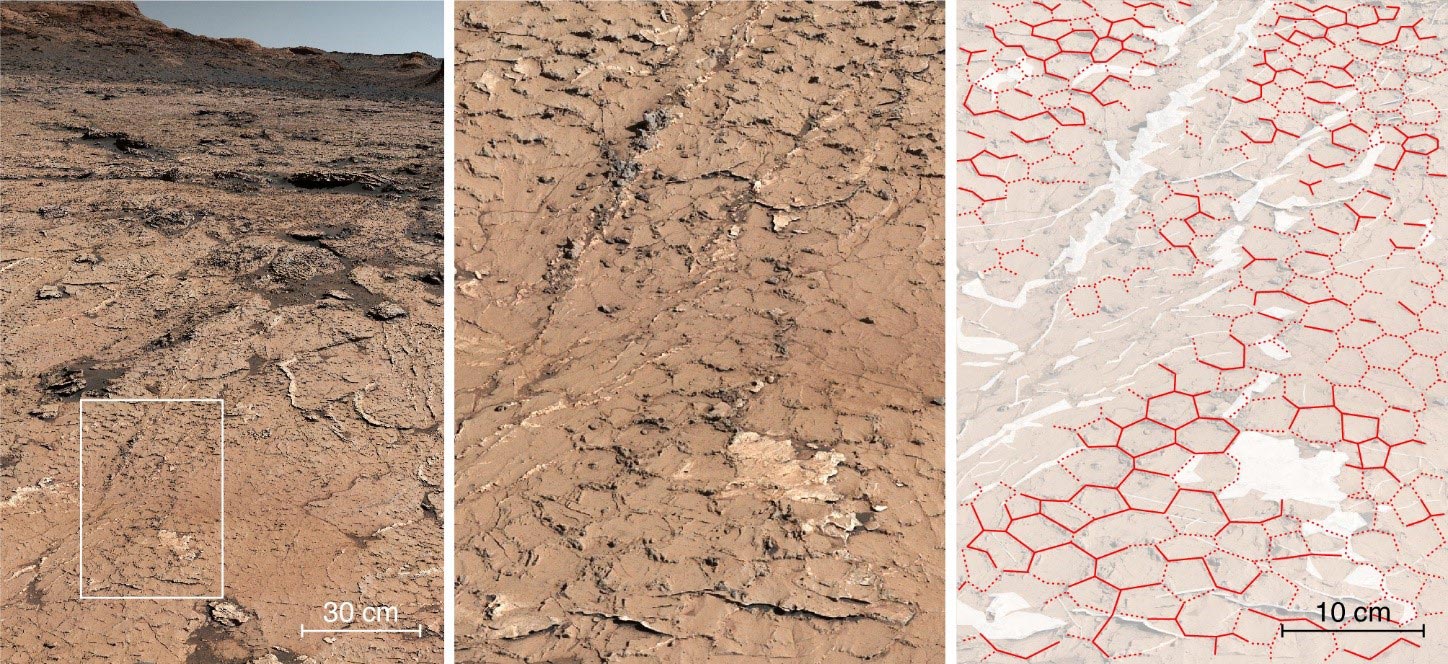A fossil hexagonal pattern in sedimentary rock analyzed by Curiosity on day 3154 of its journey through Gale Crater on Mars. Image credit: NASA/JPL-Caltech/MSSS/IRAP/Rapin et al./Nature
- Scientists have discovered fossil evidence of a cyclic climate Marswith wet and dry seasons like those on Earth.
- This environment, in which simple organic molecules were already discovered, may have provided ideal conditions for the formation of complex organic compounds.
- This work opens up new avenues for research into the processes behind the origin of life, of which there are no traces on Earth.
Use data from NASACuriosity rover, scientists have discovered patterns on the surface of Mars that provide evidence of a cyclical climate similar to Earth’s. This major discovery opens up new avenues for research into the origin of life.
The results of the study, which were carried out by scientists at the National Center for Scientific Research and the University of Toulouse III – Paul Sabatier and Claude Bernard Lyon University 1, with the participation of CNES, were published on August 9, 2023, in the journal. nature.
Mars topography and previous discoveries
The surface of Mars, unlike Earth, is not constantly replenished by plate tectonics. This has resulted in the preservation of huge terrain areas remarkable for the abundance of fossil rivers and lakes dating back billions of years. Since 2012, NASA’s Curiosity rover, the first rover to explore such ancient remains, has already detected the presence of simple organic molecules. These particles can be formed by both geological and biological processes.
conditions for the formation of life
However, scientists hypothesized that the emergence of primitive forms of life initially required favorable environmental conditions for the spontaneous organization of these molecules into complex organic compounds. These conditions are precisely what was recently discovered by a research team from the Institute for Research in Astrophysics and Planets (CNRS / Université de Toulouse III – Paul Sabatier / CNES) and the Laboratory of Geology: Terre, Planètes, Environment (CNRS / ENS) de Lyon / Université Claude Bernard Lyon 1 ), with colleagues from the United States and Canada.
Evidence for Martian climate patterns
Use of Mastcam and ChemCam tools curiousityThey discovered salt deposits that form a hexagonal pattern in sedimentary layers dating from 3.8 to 3.6 billion years ago. Similar to the hexagons observed in the seasonally drying earthen basins, they are the first fossil evidence of a sustained, periodic, regular Martian climate with dry and wet seasons. By allowing the molecules to interact repeatedly at different concentrations, independent laboratory experiments have shown that this type of environment provides the ideal conditions for the formation of complex precursors and life-forming compounds, such as RNA.
Conclusion: future research opportunities
These new observations should enable scientists to take a fresh look at the large-scale images obtained from orbit, which have already identified many terrains of similar composition. They now know where to look for traces of the natural processes that gave rise to life, of which there are no traces left on Earth.

This artist’s concept shows NASA’s Mars Laboratory’s Curiosity rover, a mobile robot to investigate the past or present capacity of Mars to sustain microbial life. Credit: NASA/JPL-Caltech
NASA’s Curiosity rover
NASA’s Curiosity rover is a car-sized robotic rover that has been exploring Gale Crater on Mars since its landing on August 6, 2012. As part of NASA’s Mars Science Laboratory (MSL) mission, Curiosity’s primary goal is to determine if Mars has ever been exposed. . Environmental conditions suitable to support microbial life. To this end, it is equipped with a variety of instruments that allow it to conduct unprecedented scientific studies of the Martian surface.
Mastcam is a vital instrument aboard Curiosity and plays an important role in exploring and analyzing the geological features of Mars. It is made up of two camera systems mounted on the rover’s “mast,” or “head,” which gives it a good location to take pictures of the Martian terrain.
ChemCam is a suite of remote sensing instruments, including a camera, laser and spectrometer, used to investigate the chemistry of rocks and soils on Mars.
Together, the Mastcam and ChemCam instruments provide a detailed visual and chemical understanding of the Martian terrain, allowing scientists to study the planet’s geology and habitability with unparalleled depth and precision.
Reference: “Continuation of the Wet-Dry Cycle in Early Mars” by W. Rabin, J. Drummart, B.C. Clarke, G. Schipper, S. Kite, L.C.Kah, L.M. Thompson, O. Gasnow, J. Laso, P. Meslin, PJ Gasda and NL Lanza, Aug. 9, 2023, Available Here. nature.
DOI: 10.1038/s41586-023-06220-3

“Typical beer advocate. Future teen idol. Unapologetic tv practitioner. Music trailblazer.”






More Stories
How did space dangers affect the asteroid Ryugu?
Scientists think they’ve discovered the source of ‘individual radio circuits’
Bird Brains: Jays show episodic-like memory